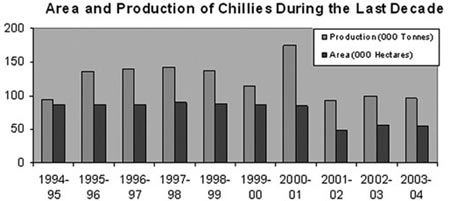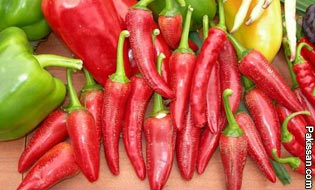|
Chillies’ potential for better economic returns
Home
By Khurram Ziaf, Qumer Iqbal &
Dr Muhammad Amjad
 THERE
has lately been a trend worldwide to emphasise over the
production of non-staple crops, particularly horticultural
(vegetables) and medicinal crops, as these have great
potential for economic returns. More emphasis is now being
placed on marketing techniques. THERE
has lately been a trend worldwide to emphasise over the
production of non-staple crops, particularly horticultural
(vegetables) and medicinal crops, as these have great
potential for economic returns. More emphasis is now being
placed on marketing techniques.
Vegetable and spice crops have great scope. Currently, only
six per cent of the total cropped area is under
horticultural crops, while vegetables are cultivated on
about two per cent. Demand of horticultural products is
increasing fast. Chilli is gaining importance because of its
high cash value.
In Pakistan, only two species viz. Capsicum annum and
Capsicum frutescens are known and most of the cultivated
varieties belong to the species Capsicum annum. Chilli
extensively grown for dry chilli (powder) is also harvested
green. There are many nutritional, medicinal and economic
benefits of its production.
Culinary applications: Chilli is not only an important
ingredient in food but is also used for essence production.
It is used in foods for pungency and red colour while it
also contributes in part to the flavor of ginger ales.
Chillies are an excellent source of vitamins A, B, C, E and
P.
 Vitamin
P in green chillies is considered to be important as it
protects from secondary irradiation injury. These contain
more vitamin C (340 mg per 100 gram) than the usual
recommended doses; more at green stage than the ripened.
Processed forms of chillies retain most of their vitamin C
content, except for dried ones. Vitamin
P in green chillies is considered to be important as it
protects from secondary irradiation injury. These contain
more vitamin C (340 mg per 100 gram) than the usual
recommended doses; more at green stage than the ripened.
Processed forms of chillies retain most of their vitamin C
content, except for dried ones.
Medicinal value: Chillies are valued for their soothing
effects on the digestive system, relief from symptoms of
cold, sore throats and fever, circulation especially for
cold hands and feet and as a hangover remedy. Chillies can
act as a heart stimulant, which regulates blood flow and
strengthens the arteries, possibly reducing heart attacks.
Medicinally, capsaicin is being used to alleviate pain. It
is the most recommended topical medication for arthritis.
The pungency in chillies is due to an alkaloid capsaicin,
which has high medicinal value. Capsaicin causes prostate
cancer cells to kill themselves. Currently, capsaicin is
used topically in proprietary creams to treat pain and
neuropathies, whereas formerly chilli-impregnated plasters
and poultices were used.
Chilli peppers, especially hotter varieties such as Cayenne
and Habanero, can also be used externally as a remedy for
painful joints, for frostbite and applied directly to stop
bleeding. They stimulate blood flow to the affected area,
thus reducing inflammation and discomfort.
It is also used in homeopathy. A non-conventional use of
chilli is in the self-defence sprays which are gaining
popularity in the US. These sprays consist of capsicum
oleoresin at ultra high emission rate which temporarily
immobilizes the attacker. Besides all these, it is the
compound that is the active ingredient of some of the
organic insect and animal deterrents and the active
component in the human deterrent 'Mace'.
Domestic production and economic value: Chillies are grown
on an area of 38.4 thousand hectares with production of 90.4
thousand tones, with an average yield of 1.7 tons per
hectare with 1.5 per cent share in the GDP. Sindh is the
major producer of chillies followed by Punjab and
Balochistan.
Pakistan earned Rs1.127 billion during 2003-2004 by
exporting red chilli powder, whereas, export earnings from
all fruits were Rs5.912 billion during the same period. This
reveals the potential of this non-staple crop. Despite its
importance the yield has declined from 86.5 (1994-95) to
55.8 thousand tons (2003-04) (Figure 1). This decline in
yield is due to a number of factors including poor quality
seed, mal-cultural practices and diseases like viruses,
collar rot and phytophthora root rot.
World market for chillies: India is the largest producer of
chillies in the world contributing 25 per cent of the total
world production, of which only four per cent is exported
because of high domestic consumption. Besides India, other
major producers and exporters are China, Pakistan, Morocco,
Mexico and Turkey (Figure 2). Major importers of chillies
from Pakistan are Gulf States, the US, Canada, Sri Lanka,
the UK, Singapore and Germany. It is exported in different
forms: fresh chillies, stalk less chillies, green chillies,
chilli powder and also as oleoresin.
Aflatoxin and chemical residues are two major constraints in
the export of chillies to Europe, Japan and the US as buyers
expect a high degree of hygiene and sanitation in processing
and preparing chillies for export.
Export of red dried chillies from Pakistan has declined from
Rs1.127 billion (during 2003-2004) to Rs846 million after
European Union food authorities have detected the presence
of aflatoxin (Pakistan Horticulture Development and Export
Board (PHDEB).
The potential for increasing exports of whole, powder and
crushed chillies in consumer packs is very high, provided we
meet the stringent quality requirements of importing
countries by preventing contamination from external sources
during harvesting, post-harvest handling, processing and
storage. This can be achieved only through an integrated
approach with the collective efforts of farmers, processors
and traders.
Future strategies and priorities: In the context of
decreasing landholding of Pakistani farmers, production of
non-staple crops like chillies seems to be most
remunerative. In coming years, this crop can boost the
economy if following steps are taken.
Farmers should be given subsidy to purchase all inputs and
the availability of high quality seed of high yielding
varieties or hybrids should be ensured.
By growing F1 hybrids, production of both fresh and powdered
chillies can be increased manifolds. This will help to
reduce yield gap between Pakistan (1.7 tons/hectare) and the
other chilli producing countries like China (17
tons/hectare) and will increase export earning.
There is a need to produce local hybrids, which will have
more adaptation than the exotic (imported) ones.
Off-season production technology to extend production season
of the crop for about two to three months is evolved. It
will also help farmers have early crop, which will benefit
them by giving more returns, as prices are high in the early
part of the growing season.
Disease-free seeds should be used by treating them with
suitable fungicide like thiram or captan. During nursery
raising, proper cultural practices should be adopted
particularly the maintenance of proper soil moisture to
avoid phytophthora root rot and collar rot. While after
transplanting, proper insect-pest control measures should be
carried out to check the population of sucking insects,
which are the vector for viral diseases affecting the chilli
crop.
To reduce aflatoxin contamination, some precautionary
measures should be adopted. These include: picking and
drying of fruit with pedicel (fruit stalk), avoid direct
contact of fruit with soil, proper drying of fruit and
storage of powder at low relative humidity and temperature.
Furthermore, agronomic factors that may influence aflatoxin
development like stresses, irrigation, cropping pattern,
variety, date of planting, date of harvesting and storage
conditions, should be studied in detail.
.
Courtesy: The DAWN
|
Pakissan.com;
|